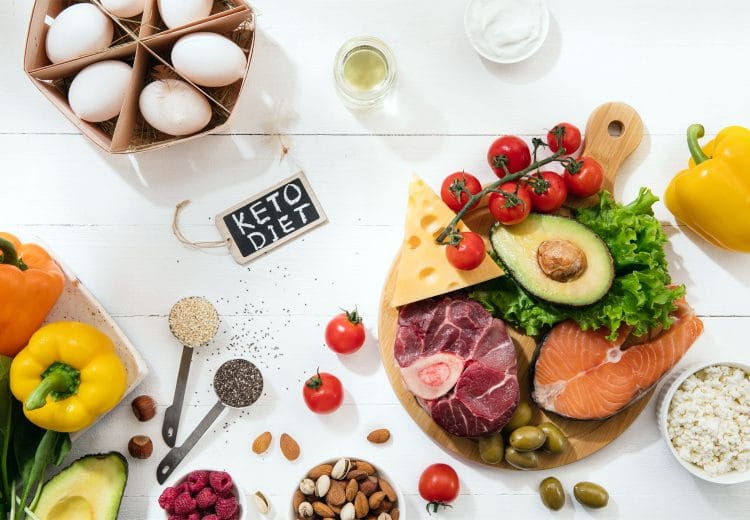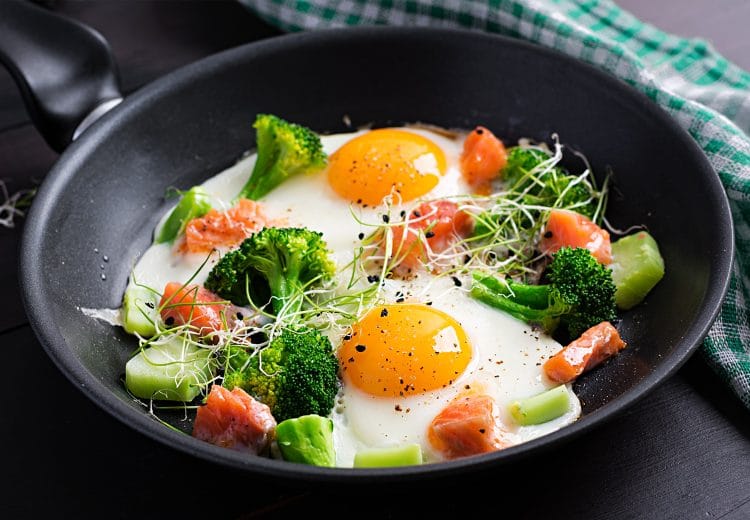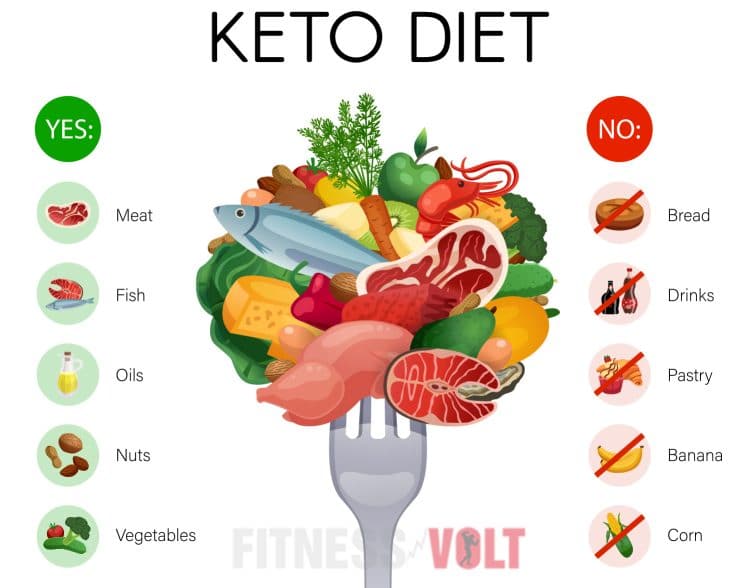The keto diet has fast become one of the most popular ways to shed weight. It involves eating a low-carb, high-fat, and moderate-protein diet.
Following a low-carb diet forces your body into using fats as its main energy source instead of glucose. This process is known as ketosis and is how the keto diet got its name.
Keto Diet — Introduction
If you are in the market for a diet program, you are probably drowning in nutritional information being thrown at you from all directions. Keto, intermittent fasting, paleo, vertical diet, reverse dieting, and IIFYM are a few of the popular diets amongst fitness enthusiasts. We won’t lie — things can get too overwhelming too soon.

Before you start a new diet program, you should know its pros and cons. Choosing the wrong diet can set you back on your transformation journey by at least a couple of months — a month can mean a lifetime if you are working with a deadline.
When people think about losing weight and body fat, their first step usually involves cutting out the fat from their diet. According to the rookies, the macronutrient is the main culprit behind their spare tire. The mindset is based on the misconception that eating ‘fats’ makes you fat. The keto aka ketogenic diet turns this concept on its head.
Your high caloric intake (carbs, fats, or protein) coupled with a lack of physical activity is the real reason behind your weight gain, not the macro ‘fats’ themselves.
Level Up Your Fitness: Join our 💪 strong community in Fitness Volt Newsletter. Get daily inspiration, expert-backed workouts, nutrition tips, the latest in strength sports, and the support you need to reach your goals. Subscribe for free!
Studies have shown that eating a high-fat diet (keto) is significantly more effective at helping you lose weight than low-fat diets.
On top of this, ketosis can be a godsend for lifters as ketones produce more ATP than glucose and are referred to as a “super fuel.” ATP fuels cell energy and is important for muscle contractions, nerve impulse propagation, ion transport, chemical synthesis, and substrate phosphorylation. In layman’s terms — ketones are your friends if you want to build muscle mass.
Macronutrient Intake on a Keto Diet
Keto is a high-fat diet, but that does not mean you can do away with the other two macros. Each macro has a unique role to play in the basic functioning of your body, and you should not eradicate any of them from your diet completely.
The basic premise of the keto diet involves replacing a large portion of carbohydrates with fats and protein.
The Ideal Macro Structure While Following a Keto Diet
The most common type of keto diet consists of the following macro ratio:
- Fats: 70-80%
- Protein: 20-30%
- Carbs: 5-10%
If the macronutrient ratios mentioned above are a little too harsh for you, you could begin with 55-60% fat, 30-35% protein, and 5-10% carbohydrates.
As a rule of thumb, the lower your carb intake, the easier it will be for you to achieve and stay in ketosis.
If you are following a 2,000 kcal per day diet, you might achieve the state of ketosis by eating 20 or fewer grams of carbohydrates per day. However, eating a higher-calorie diet does not give you a pass to eat more carbs. You will have to stay within the 20-30 grams of carb range even if you are eating a 4,000 kcal diet.
Check out our Keto Calculator to determine your ideal daily macro goals while following a keto diet.
Foods To Eat on a Keto Diet
Here are the foods that you should load your shopping cart with:
- Butter and Cream: grass-fed butter and heavy cream
- Meat: red meat, steak, ham, sausage, bacon, chicken, and turkey
- Low Carb Veggies: green veggies, tomatoes, onions, peppers, etc.
- Nuts and Seeds: almonds, walnuts, flaxseeds, pumpkin seeds, chia seeds, etc.
- Eggs: pastured or omega-3 whole eggs
- Cheese: unprocessed cheeses like cheddar, goat, cream, blue, or mozzarella
- Healthy Oils: extra virgin olive oil, and avocado oil
- Avocados: whole avocados or freshly made guacamole
- Fatty Fish: salmon, trout, tuna, and mackerel
- Condiments: salt, pepper, herbs, and spices
Foods To Avoid on a Keto Diet
The following foods can bring you out of the state of ketosis:
- Low Fat or Diet Products: low-fat mayonnaise, salad dressings, and condiments
- Sugary Foods: soda, fruit juice, smoothies, cake, ice cream, candy, etc.
- Sugar-Free Diet Foods: sugar-free candies, syrups, puddings, sweeteners, desserts, etc.
- Fruit: all fruit, except small portions of berries like strawberries
- Alcohol: beer, wine, liquor, mixed drinks
- Beans or Legumes: peas, kidney beans, lentils, chickpeas, etc.
- Root Vegetables and Tubers: potatoes, sweet potatoes, carrots, parsnips, etc.
- Some Condiments or Sauces: barbecue sauce, honey mustard, teriyaki sauce, ketchup, etc.
- Unhealthy Fats: processed vegetable oils, mayonnaise, etc.
- Grains or Starches: wheat-based products, rice, pasta, cereal, etc.
Types of Keto Diets
There are a few variations of the keto diet present on the market, the most common of which include:
1. Standard Ketogenic Diet (SKD)
It is the most common and basic version of the diet. The typical macro breakdown on the SKD consists of 70-75% fat, 20% protein, and 5-10% carbs.
2. High-Protein Keto Diet
The high-protein keto diet includes eating more protein than you would on an SKD. Your macro ratio on this variation would consist of 35% protein, 60% fat, and 5% carbs.
3. Cyclical Ketogenic Diet (CKD)
Also known as carb backloading, this variation of the keto diet involves days in which more carbs are eaten. For example, you might follow an SKD diet for the first five days of the week and then follow it up with two days of higher carb days.
The CKD diet is usually followed by athletes, as they can use the higher carb days to replenish the glycogen lost from muscles during workouts.
4. Targeted Ketogenic Diet (TKD)
The TKD is similar to SKD except that carbs are consumed around workout times. This keto variation is an SKD and CKD hybrid that allows you to make the most of your workouts by consuming carbs around your training time.
Level Up Your Fitness: Join our 💪 strong community in Fitness Volt Newsletter. Get daily inspiration, expert-backed workouts, nutrition tips, the latest in strength sports, and the support you need to reach your goals. Subscribe for free!
Benefits and Disadvantages of Keto Diet
Here are the pros and cons of a keto diet you should consider before starting your transformation journey:
Benefits of Keto Diet
1. Helps You Feel Fuller For Longer
Individuals struggling with excess bodyweight issues usually are in the habit of snacking throughout the day. However, the high-fat nature of the keto diet can help keep you feeling full for longer.
The satiety characteristic of the diet can keep you from munching on high-carb foods that can add to your waist size.
2. Can Help Prevent/Improve Diabetes
Obesity is one of the biggest causes of Type 2 diabetes. In a study conducted on 28 overweight subjects, keto dieting improved glycemic control to the point where some participants were able to discontinue diabetes medication. Others successfully reduced their medication dosage.
3. One of the Best Diets For Weight Loss
Simply put, a keto dieting preaches “eat fat to burn fat.” There is enough scientific evidence to back the fact that a keto diet is one of the best diets to help you lose weight.
You do not even need to read countless pages of scientific literature to be convinced of keto’s weight loss effectiveness — a little common sense will do.
Let’s do a simple exercise, shall we? (It is for people currently not following the keto diet.)
Pull out your phone and fire up your favorite macro tracking app. Input one day’s worth of meal data. Chances are, your carb intake will be between 35-50% of your total calorie intake. Your body stores the excess carbs in the form of glycogen — causing fat build-ups.
Compare this to the keto diet where your total carb intake will max out at 10% of total calorie intake.
If you are eating a high-carb diet, you will probably see a sudden weight drop as soon as you switch to a keto diet.
4. Other Health Benefits of Keto
Several studies have shown that the high-fat diet can have benefits for a wide variety of health conditions, including cancer, heart disease, Alzheimer’s, Parkinson’s, polycystic ovary syndrome, and brain injuries.
Notably, the ketogenic diet originated as a tool for treating neurological diseases such as epilepsy, and research has proven its effectiveness in treating the disorder.
Cons of Keto Diet
1. Regular Checkups
A keto diet is an extreme form of dieting as it requires you to keep your carb intake substantially low.
As per research, consuming fewer than 50 grams of carbs per day can cause flu-like symptoms, also known as the keto flu. It is caused by dehydration and electrolyte imbalances that happen as your body adjusts to ketosis.
To ensure you are not facing any nutritional deficiencies, you should undergo regular checkups.
2. Difficult to Sustain
Since keto imposes stringent food restrictions, your food options are limited. Individuals who do not have strong willpower or important enough goal might find it hard to stick to the diet.
Also, sticking with the ketogenic diet in the long term can put you at a risk of facing micronutrient deficiencies, low protein in the blood, extra fat in the liver, and kidney stones.
3. Can Cause Renal Issues
People with kidney disease have an increased risk of requiring dialysis on the keto diet due to the additional ketones their renal system has to process.
Sample 7-Day Keto Meal Plan

If you are sold on the keto diet but do not know where to start, we have you covered. The following seven-day ketogenic is designed for an individual weighing between 170-190 pounds:
Day 1: Monday
- Breakfast: Scrambled eggs in butter on a bed of lettuce topped with avocado
- Snack: Sunflower seeds
- Lunch: Spinach salad with grilled salmon
- Snack: Celery and pepper strips dipped in guacamole
- Dinner: Pork chop with cauliflower mash and red cabbage slaw
Day 2: Tuesday
- Breakfast: Bulletproof coffee (made with butter and coconut oil), hard-boiled eggs
- Snack: Red bell pepper with two tablespoons ranch dressing
- Lunch: Tuna-celery salad with mixed greens and cherry tomatoes
- Snack: Celery with two tablespoons cream cheese
- Dinner: 7 oz bone-in pork chop with cauliflower-cheddar mash
Day 3: Wednesday
- Breakfast: Cheese and veggie omelet topped with salsa
- Snack: Plain, full-fat Greek yogurt topped with crushed pecans
- Lunch: Sashimi takeout with miso soup
- Snack: Smoothie made with almond milk, greens, almond butter, and protein powder
- Dinner: Roasted chicken with asparagus and sautéed mushrooms
Day 4: Thursday
- Breakfast: Cheese and spinach omelet topped with avocado and salsa
- Snack: Two hard-boiled eggs
- Lunch: Chicken tenders made with almond flour on a bed of greens with cucumbers and goat cheese
- Snack: ½ medium zucchini cut into sticks and 1 oz Monterey jack cheese
- Dinner: 5 oz hamburger topped with 1 oz pepper jack cheese, 1 small tomato, ½ Hass avocado, and 2 romaine lettuce leaves
Day 5: Friday
- Breakfast: Fried eggs with bacon and a side of greens
- Snack: A handful of walnuts with a quarter cup of berries
- Lunch: Grass-fed burger in a lettuce “bun” topped with avocado and a side salad
- Snack: Celery sticks dipped in almond butter
- Dinner: Baked tofu with cauliflower rice, broccoli, and peppers, topped with a homemade peanut sauce
Day 6: Saturday
- Breakfast: Red bell pepper filled with creamy eggs and spinach
- Snack: Kale chips
- Lunch: Tuna salad with 4 oz tuna, 2 stalks celery, 1 dill pickle spear, 2 tbsp mayonnaise
- Snack: 1 portobello mushroom cap, ¼ cup salsa cruda, and 1 oz pepper jack cheese
- Dinner: 5 oz Italian sausage, ¼ medium onion sliced, and ½ red bell pepper sliced with a side of 2 cups baby spinach, ½ cup sliced mushrooms, and 2 Tbsp Blue Cheese Dressing
Day 7: Sunday
- Breakfast: Eggs scrambled with veggies, topped with salsa
- Snack: Dried seaweed strips and cheese
- Lunch: Sardine salad made with mayo in half an avocado
- Snack: Turkey jerky (look for no added sugars)
- Dinner: Broiled trout with butter, sautéed bok choy
Supplements on a Keto Diet
Using these supplements while following a keto diet can help you achieve your fitness goals:
- Whey Protein
- Creatine
- Caffeine
- Multivitamins
- MCT Oil
- Exogenous Ketones
How to Know if You are in the State of Ketosis
One of the most common questions people have when they begin a keto diet is how would they know if their diet is working and they have entered the state of ketosis. There are a few ways of confirming this, including:
- As per research, you could lose up to 10lbs of water weight in the initial two weeks of starting a keto diet. The diet acts as a diuretic, and you will find yourself taking more trips to the loo after switching to the ketogenic diet program.
- The low-carb nature of the diet can give you flu-like symptoms in the initial days. The phenomenon is so common they even have a name for it — keto flu. Common symptoms include headache, nausea, fatigue, constipation, irritability.
- You might experience an energy crunch and brain fog as your body adjusts to the keto diet.
- Keto breath is an unwanted side effect of ketosis. It produces a distinct metallic taste in the mouth. Besides the taste, your breath can be fruity-smelling or have a strong odor that’s similar to nail polish remover.
- Due to the high-fat nature of the keto diet, you’ll experience a decreased appetite.
- You might notice reduced cravings for sugar.
However, if you want to be absolutely sure about the state of your ketosis, you could use a urine ketone strip, blood ketone meter, or a breath ketone analyzer.
Wrapping Up
The keto diet may help with weight loss, blood sugar control, and other health goals. However, it is an advanced form of dieting, and you should consult your physician or dietician before switching to a ketogenic nutrition program.
While most people follow this diet to reach a weight goal, you could follow the program for the longer term, given you keep an eye on your vitals and undergo regular health checkups.











